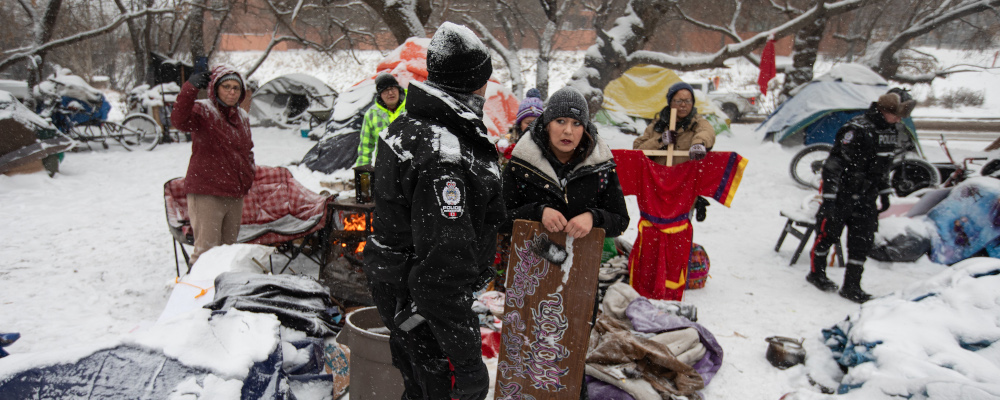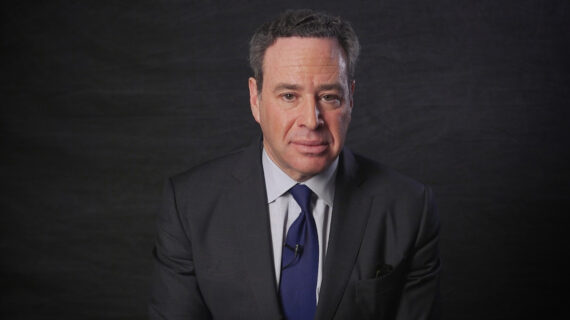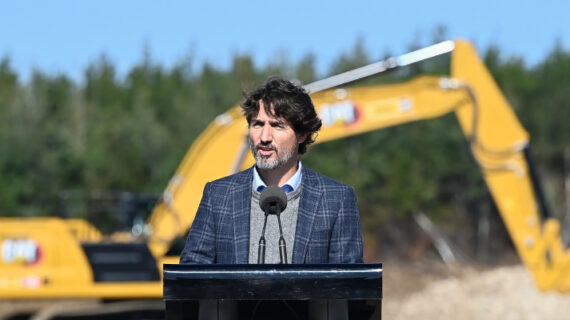In the face of the recent frigid temperatures, cities across the country have struggled with questions about homeless encampments, public safety, and the well-being of the affected individuals. The City of Edmonton has been on the front lines of these policy debates which can often assume an ideological dynamic.
Recently, as the Edmonton Police Services shut down a homeless encampment and sought to move its residents into indoor shelters, the commentator and Mount Royal University political science professor Duane Bratt provided some insight into how direct responses to social disorder are sometimes perceived. He tweeted: “I do not know what the answer is. But this looks really bad. Police tearing down homemade shelters and arresting people in the dead of winter.” On the more radical edge of the progressive movement, the writer and “drug user liberation” activist Euan Thomson re-upped his recent essay describing such encampment shutdowns as “mass murder” and “a war on the poor.” Somewhere in the middle, we find Edmonton Mayor Amarjeet Sohi acknowledging concerns about the encampments, but still noting his worry that poverty cannot be “stigmatized or criminalized.”
In these comments, we can identify two instinctive difficulties with how many Canadian progressives approach this issue. First, there is an obvious discomfort with solutions that “look bad,” and second, among the more strident advocates, there is an assumption that limiting people’s autonomy, particularly through police power, is akin to killing them. The more radical view makes its way back into the mainstream as a sort of vibe or instinct. Where the radical advocate will call police officers “pigs” for enforcing the law, more moderate progressives have just developed an instinctive discomfort with seeing police arrest people.

The trouble with these instincts in both their strong and weak forms is that genuine progress on issues like homelessness, crime, and drug addiction often must “look bad” in the short term and do require society to limit others’ autonomy, in large part for their own good. A practical approach to public policy requires us to get over these difficulties and develop better instincts in their place.
For example, temperatures in Alberta dropped below -40℃ with the windchill earlier this month. At that temperature, you can get frostbite within minutes, and freezing to death is possible—almost certain if you are so strung out or intoxicated that you don’t notice what’s happening to you. Campfires and makeshift heaters can light a nylon tent on fire quite easily, and there are horrific reports of encampment residents burning to death in their tents.
If all that wasn’t bad enough, many of Edmonton’s homeless encampments have been infiltrated by criminal gangs that extort, threaten, and prey upon their most vulnerable residents. Nature abhors a vacuum, so when government cedes control of some parts of our cities, other authorities emerge. These other authorities are not the peaceable matrons of an imagined commune; they are often those most willing to exercise violence to maintain their profits and control, including gangs like Redd Alert.
Despite this, residents of the camps don’t always want to leave, even when there is ample shelter space available, as there has been for the last several weeks. We should all sympathize with these people’s plight.1The journalist Brandi Morin movingly recorded and described some residents’ sadness, anger, and fear in her report from a recent encampment clearing. Many of them struggle with mental health conditions and addictions, and their lives have been torn apart by trauma. They are often not in a position to look after their own best interests.
That’s where the rest of society comes in. When homeless members of our community are putting themselves at risk by living in gang-run encampments in the dead of winter, we simply must insist that they leave their tents and go inside. To do that, we occasionally need to use police powers, including arresting people and sending them to (well-heated) prisons if they are defying lawful orders.
A shallow understanding of mercy is at work among the people who want to keep these camps open. They are so intent on respecting the autonomy of the camp’s residents that they are willing to let them freeze to death. A deeper understanding of mercy—and of human dignity and the bonds of shared citizenship—recognizes that we are all bound up with each other and that therefore we shouldn’t just allow our neighbours to risk killing themselves. A deeper understanding of autonomy recognizes that you’re not truly free to make decisions if you live at the mercy of addictive drugs and the criminal gangs who sell them to you. Indeed, removing people from those gangs’ clutches and helping them into recovery from addiction is a way of restoring them to genuine freedom.
In the wake of the cold snap, various parts of Alberta’s government took a promising step in that direction, with Deputy Premier Mike Ellis, Jason Nixon, the Minister of Seniors, Community, and Social Services, and Dale McFee, the Chief of the Edmonton Police Services, announcing their intention to continue dismantling the city’s homeless encampments, beginning with those considered most dangerous.
Joined by Chief Wilton Littlechild and Treaty Six Grand Chief Cody Thomas, the ministers said they would establish a one-stop “navigation centre” to receive, treat, and assist those evicted from the encampments. Warm beds and hot showers, a safe place to eat, sleep, and store their possessions, and help to get into longer-term shelters, including some operated by Indigenous communities—these are the kinds of practical steps that can actually help. As Grand Chief Thomas put it, “We’ve got to act now, because people are dying, [and] encampments aren’t a safe spot for anybody to live.”

But our instinctual difficulties with practical solutions like these can still pose problems at a more systemic level.
For example, a common criticism of homeless shelters is that they are unsafe, with residents stealing others’ possessions, consuming drugs and alcohol, and acting out violently. Indeed, encampment advocates often cite the unsafe conditions as proof that appropriate shelter isn’t available.2CBC reporter Michelle Bellefontaine made this point repeatedly in her questions at a press conference on the issue, prompting vehement disagreement from Chief McFee, who said he was “almost flabbergasted” by the suggestion that living outside in a tent at -40℃ was somehow safer than going inside a shelter indoors.
Let’s stipulate the point. Some shelters are not as safe as they should be. The solutions here are obvious. Ensure police and security staff are posted in homeless shelters. Arrest people when they break the law, both to stop the immediate harms and to deter others from causing such harms in the future. Don’t let those you have arrested out on bail if they are likely to reoffend right away.3If our judges won’t do this, our federal parliament can pass bail reform legislation to limit their discretion, including by preemptively applying Section 33 of the Charter to forestall a drawn-out journey past activist judges.
Luckily policies like these need not be too punitive. Evidence from B.C. suggests that a disproportionate share of violent crimes are committed by a small number of repeat offenders, including some who are released on bail and reoffend that very day. We would all be better off if these prolific offenders were in prison. Indeed, the people who would benefit most from this are the more peaceful residents of Canada’s many homeless quarters who are the people most likely to be victimized by their violent neighbours.
With greater physical safety in shelters and temporary housing, our homeless neighbours could take better advantage of them. They would gain a clean and safe place to rest and a more stable setting to start putting their lives back together. Without the constant threats of violence, staff at homeless shelters could relax a bit and perhaps show some more sympathy in their enforcement of various rules and regulations. After all, it’s hard for workers at a homeless shelter to let down their guard and really listen to someone in distress if they are worried they are going to be attacked. We can and should reduce this worry.
This would also benefit the incarcerated repeat offenders themselves. Again, it looks bad to imprison someone, but there are people for whom the best place is in fact prison, at least for now. Between their crimes and the chaos in their lives, they will do less harm to others and themselves if their autonomy is limited and they are offered the stability and restraint they need to reset their lives.
It’s a hard truth, and it’s one I came to reluctantly. I myself had once adopted some of the reflexive anti-policing instincts so common to our discourse. The change in my thinking was prompted by experience. Before moving to Alberta, I spent several years volunteering in prison ministry in Surrey, as well as being part of a circle of support and accountability for released offenders in Vancouver’s Downtown Eastside. Meeting with prisoners, reading Gospel passages with them, and listening to how they could connect them to their lives, I heard the same story again and again. They didn’t like being in prison, but they recognized that what they were doing needed to be stopped and that imprisonment offered them the possibility of a hard reset.

To some urban residents, what looks really bad is the prospect of moving people into temporary housing in their own leafier, more desirable neighbourhoods—even though these are much better settings for putting your life together. Among the offenders out on parole I interacted with, I was struck by just how challenging a successful release could be in a place like the Downtown Eastside. The area is chaotic, soul-crushing, and filled with temptations for those who are trying to reset their lives, and yet that is where most of the Lower Mainland’s halfway houses are located.
It looks bad to have the cops patrolling around these new housing facilities, arresting people for shooting up in the gutters—but crime often increases in the neighbourhoods where these facilities are built and neighbours are rarely going to welcome them if they don’t believe municipal governments are serious about keeping their communities safe.
Stepping further back, these instincts have contributed to many of Canada’s social problems. It looks bad to talk about reducing immigration and we wouldn’t want to limit the autonomy of foreign students when they come here to work—but accidentally increasing our low-wage population by over 800,000 people contributed to the rent crisis that’s helping to force more of our neighbours into these encampments.
The list could go on. Progress in addressing a whole range of social problems will come when our leaders replace their unhelpful instincts with more practical ones. They need to get more comfortable with policies that look bad in a video clip but ultimately benefit the whole community, especially the most vulnerable. And they need to come to a more thoughtful understanding of what mercy and respect for people’s autonomy actually look like in these kinds of situations. It can be a tough sell, but it’s one our leaders ought to make.




